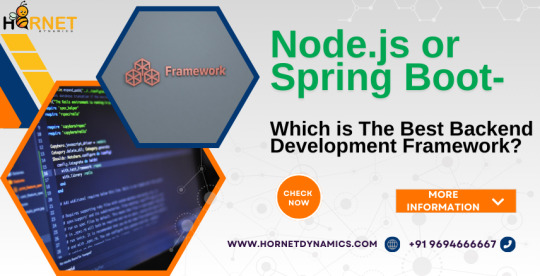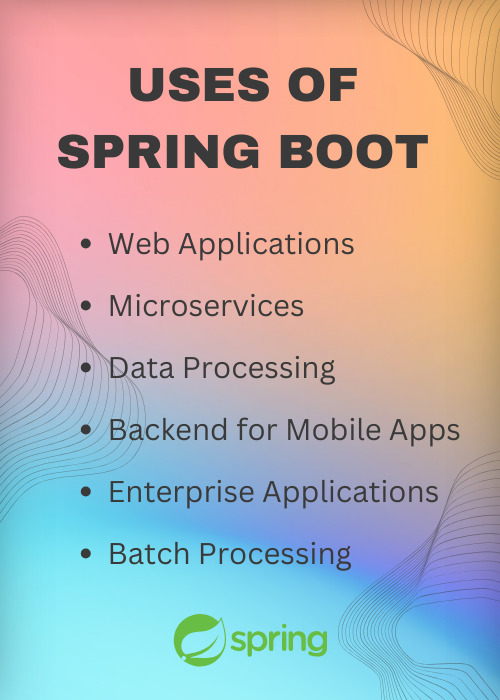#Spring Boot Framework
Explore tagged Tumblr posts
Text
Spring Boot Full Course: Learn Microservices and REST API Development
visit the blog: https://medium.com/@tpointtechblog/spring-boot-full-course-learn-microservices-and-rest-api-development-3e9a9f9ab226
visit more blog:
https://dev.to/tpointtechblog/master-css-fast-the-only-tutorial-youll-ever-need-5dfb
https://www.linkedin.com/pulse/what-c-used-key-concepts-real-world-applications-udhav-khera-cy82c
https://tpointtechblog.hashnode.dev/your-ultimate-artificial-intelligence-ai-tutorial-build-smart-systems
https://www.patreon.com/user?u=169347449
https://themediumblog.com/read-blog/167561
https://sites.google.com/view/dbmstutorial/home
0 notes
Text
Java Projects for Your Resume: Why They Matter

Java Projects for Your Resume: Why They Matter
Adding Java projects to your resume can really help you land a job. Employers want to see real experience, and showcasing projects shows that you know how to apply your skills. A solid portfolio stands out more than just having certifications. These projects reflect your problem-solving skills, creativity, and understanding of Java basics and advanced concepts. Whether you’re just graduating or changing careers, having practical projects is important. Students taking Java course in Coimbatore are often encouraged to create live applications to boost their resumes and improve their chances in job interviews.
Simple Java Projects for Beginners
If you're just starting out, try adding basic Java projects like a calculator, to-do list, or temperature converter to your resume. These projects are great for grasping object-oriented programming and basic GUI design. They’re usually part of beginner exercises in Java training programs in Coimbatore, helping you learn coding logic efficiently. Working on simple applications also enhances your debugging and problem-solving skills, which are key for coding interviews. It’s a good idea for beginners to focus on these smaller projects before tackling more advanced systems.
Intermediate Java Projects That Impress
Once you’ve got the basics down, you can move on to intermediate-level Java projects for your resume, like library management systems, quiz apps, or student record management tools. These projects show that you have a better grasp of file handling, user authentication, and data structures. Many Java course in Coimbatore make sure students work on these types of projects to build real-world problem-solving skills. These applications don’t just show off your technical skills; they also demonstrate that you can create user-friendly programs.
Advanced Java Projects That Stand Out
For those with more experience, advanced projects could include chat applications, e-commerce websites, or banking systems using JavaFX or Spring Boot. These projects show that you’re skilled in frameworks, APIs, and databases. Many top Java training programs in Coimbatore include this type of work in their syllabus. Having these projects on your resume proves to employers that you’re ready for the job and can manage larger systems. Using GitHub to share your source code, along with documentation and screenshots, can give you an edge.
Importance of Full-Stack Java Projects
A full-stack Java project covers both the frontend and backend, often using HTML, CSS, JavaScript, Java, and MySQL. These projects help show that you’re not just focused on the backend but can also manage UI and databases. Joining a Java course in Coimbatore that includes full-stack content will give you an advantage in today’s job market. Such projects mimic real work environments and prove you can handle end-to-end application development.
Using Java Projects to Show Teamwork
Employers often look for teamwork skills. Including team-based Java projects on your resume, where you collaborated with others, demonstrates your ability to communicate, manage tasks, and work with version control systems like Git. Group projects in Java training programs in Coimbatore teach students how to build scalable applications with effective task management. Showcasing these projects on your resume emphasizes both your technical abilities and your teamwork qualities.
How to Present Java Projects on a Resume
When listing Java projects on your resume, make sure to include the project title, a brief description, the technologies you used, and your role in the project. Focus on the impact of your work—did it solve a real problem or improve performance? Students in Java course in Coimbatore learn how to document and present their projects for interviews. Adding links to demos or GitHub repositories is a nice touch. How you present your projects can help you stand out to potential employers.
Mistakes to Avoid While Showcasing Java Projects
Avoid listing too many projects that aren’t complete or too similar. Don’t just focus on frontend work; employers want to see sound coding and backend integration too. Students in Java training programs in Coimbatore are advised to keep their code clean, well-documented, and free of bugs. Steer clear of copying projects from the internet; instead, focus on customizing and innovating based on your learning. This shows creativity and confidence, and you'll be better prepared for questions about your projects in interviews.
How Projects Improve Your Job Readiness
Including Java projects on your resume is vital for showing you’re ready to work. It shows you can create practical applications with your skills. Employers want candidates who can contribute from day one. A strong portfolio, supported by a solid Java course in Coimbatore or good Java training program, can greatly improve your hiring chances. Recruiters appreciate real-world experience over just theoretical knowledge or course certificates.
Conclusion: Learn, Build, and Stand Out with Xplore IT Corp
If you want to get good at Java and build impressive projects for your resume, then a structured Java course in Coimbatore is a great place to start. At Xplore IT Corp, we provide relevant Java training that includes hands-on project development, resume-building workshops, and full placement support. With real experience and guidance, you can create a portfolio that impresses employers. Let your Java projects show your skills learn, build, and grow with us at Xplore IT Corp.
FAQs
1. What types of Java projects should I include in my resume?
Include a mix of simple, intermediate, and advanced projects to showcase various Java skills like OOPs, file handling, APIs, and databases.
2. How many Java projects should I list on my resume?
List 2 to 4 well-documented projects. Focus on quality rather than quantity, ensuring each project highlights a unique skill set.
3. Do Java projects really help in getting a job?
Yes, they provide evidence of your coding skills and can help you make a strong impression in interviews, especially for roles needing practical programming.
4. Where can I get help for building Java projects?
Enrolling in a Java course in Coimbatore, like the one offered by Xplore IT Corp, can provide expert guidance, resources, and structured projects.
5. Can I use GitHub to showcase my Java projects?
Definitely! GitHub is a great platform to display your work to potential employers. Include links to your GitHub projects in your resume for easy access.
#Java programming#Java developer#Java applications#Java frameworks#Java projects#Java coding#Java syntax#object-oriented programming#Java backend#Java frontend#Java database connectivity#Java Spring Boot#JavaFX#Java GUI#Java tools#Java version control#Java IDE#Java servlet#Java web development#Java interview questions
0 notes
Text
Node.js or Spring Boot- which is the best backend development Framework?

Hornet Dynamics is a renowned company in backend development and if you are searching for the answer of Which framework is best for backend application development between Node.js and Spring Boot then free yourself from this worry and come to us for every answer to your problem related to web development.
0 notes
Text
Introducción a Clientes REST en Spring Boot: Beneficios y Casos de Uso (1era. Parte)
Sección 1: ¿Por qué usar clientes REST con Spring Boot? Beneficios clave Desacoplar componentes de una aplicación: Los clientes REST permiten separar las funcionalidades de diferentes servicios, manteniendo cada uno independiente y modular. Reutilizar código: Con REST, los mismos clientes se pueden reutilizar en diferentes contextos, facilitando el mantenimiento y la eficiencia. Facilitar la…
0 notes
Text

Spring Boot Training In Electronic City Bangalore
Unlock the power of Spring Boot and Microservices! Join eMexo Technologies and elevate your career to new heights. 🚀 Enjoy a flat 40% off on course fees! Secure your spot today and blossom into a Spring Boot expert! 🌟
Course details:
https://www.emexotechnologies.com/courses/spring-boot-certification-training-course/
🚀 Why Choose Our Course?
Expert Instructors: Learn from seasoned professionals with real-world experience.
Hands-On Training: Dive into practical projects and real-world scenarios.
Flexible Schedules: Perfect for working professionals and students.
Career Support: Get job assistance, resume-building tips, and interview preparation.
Course Highlights:
In-Depth Spring Boot Framework
Building and Deploying Microservices
API Development and Management
Spring Cloud Integration
Monitoring and Logging
Next Batch Schedule
📅 Upcoming Batch: [ 29th June 2024 ]
📍 Location: [ Electronic City, Bangalore ]
💰 Special Offer: Enroll now and get a 30% discount!
Contact Us
📞 Phone: [ +91 9513216462 ]
🌐 Website: [ https://www.emexotechnologies.com/ ]
📧 Email: [ [email protected] ]
#spring boot#springbootframework#springboottraininginstituteinelectroniccity#microservices#spring framework#emexotechnologies#bangalore#electroniccity#techeducation#it training institute#itcourse#certificationcourse#education#careerdevelopment#career growth#learn to code
0 notes
Text
Web development framework
Web development framework A web development framework serves as an organized assortment of pre-written code and tools, utilized by developers to streamline the creation of websites and web applications. It furnishes a foundation and structure for constructing web-based applications, presenting a collection of predefined functions, libraries, and best practices. These frameworks are devised to…
View On WordPress
#Angular#ASP.NET#C#Django#Java#JavaScript#Laravel#MongoDB#MySQL#PHP#Python#Rails#ReactJS#Ruby#Spring Boot#TypeScript#Vue.js#Web development framework
0 notes
Text
Top Microservices Frameworks to Build Scalable Applications - Read this blog about Top 6 Micro services Frameworks to Create Scalable and powerful Application tailored to your business needs. Contact expert at Ingenious Minds Lab today for a consultation.
#Top Microservices Frameworks#Microservices Frameworks#Ballerina#Oracle Helidon#Golang#Quarkus#Eclipse Vert.X#Spring Boot
0 notes
Text
Coding By Time - Pro+

JAVA
Java, uzun yıllardan beri web geliştirmede yaygın olarak kullanılan popüler bir programlama dilidir. Web uygulamaları oluşturmak için sağlam ve ölçeklenebilir bir platform sunarak geliştiricilere üzerinde çalışabilecekleri çok çeşitli araçlar ve kitaplıklar sunar. Çok yönlülüğüne ek olarak Java, anlaşılması, bakımı ve değiştirilmesi kolay kod oluşturulmasını destekleyen Tek Sorumluluk İlkesine bağlılığıyla bilinir. Java ile geliştiriciler hızlı, güvenilir ve emniyetli web uygulamaları geliştirebilirler; bu da Java'yı web geliştirme için önemli bir araç haline getirir.
Spring
Spring Framework, Java tabanlı web uygulamaları oluşturmak için güçlü ve yaygın olarak kullanılan bir çerçevedir. Geliştiricilerin karmaşık uygulamaları kolaylıkla oluşturmasını kolaylaştıran bir dizi özellik ve araç sunar. Spring Framework kullanmanın avantajlarından bazıları şunlardır:
- Uygulama bileşenlerinin basitleştirilmiş konfigürasyonu ve yönetimi
- Diğer kütüphaneler ve çerçevelerle kolay entegrasyon
- Test etme ve hata ayıklama için güçlü destek
- Kapsamlı belgeler ve topluluk desteği
Spring Framework'ün en önemli özelliklerinden biri, geliştiricilerin URL isteklerini belirli eylemlerle eşlemelerine olanak tanıyan requestMapping'dir. Bu özellik, web uygulamalarının URL yapılarının yönetilmesini kolaylaştırarak genel kullanıcı deneyimini iyileştirir.

Spring Boot
Spring Boot, Spring Framework'ün üzerine inşa edilen ve geliştiricilere web uygulamaları oluşturma konusunda daha hızlı ve daha akıcı bir yaklaşım sağlayan bir araçtır. Spring Boot ile geliştiriciler minimum yapılandırmayla web uygulamaları ve mikro hizmetler oluşturabilir, bu da web geliştirmeye başlamayı kolaylaştırır. Spring Boot'u kullanmanın faydalarından bazıları şunlardır:
- Uygulama bileşenlerinin basitleştirilmiş konfigürasyonu ve yönetimi
- Geliştirilmiş performans ve ölçeklenebilirlik
- Diğer kütüphaneler ve çerçevelerle kolay entegrasyon
- Kapsamlı belgeler ve topluluk desteği
Spring Boot ayrıca önbelleğe alma desteği, reaktif akış API'si ve URL eşleme dahil olmak üzere web uygulaması geliştirmeye yönelik bir dizi özellik ve araç sunar. Kullanım kolaylığı ve kapsamlı araç seti sayesinde Spring Boot, hızlı ve verimli bir şekilde sağlam ve ölçeklenebilir web uygulamaları oluşturmak isteyen geliştiriciler için popüler bir seçim haline geldi. Ayrıca Visual Studio Code, çeşitli kullanışlı VS Code uzantılarıyla Spring Boot uygulama geliştiricileri için ideal bir hafif geliştirme ortamı sağlar. Bu gibi bilgilendirmeler ve geliştirmeler için web sitemizi ziyaret edebilirsiniz.
2K notes
·
View notes
Text
youtube


Camille Lemoine



Gemma Dagger


Rachel Lamb

Wendy McMurdo






Izzy Leach




Margaret Mitchell
https://diormagazine.dior.com/dior-magazine-en/dior-magazine-48/fashion/from-dior-to-scotland
Christian Dior - Cruise 2025
Highlands, Tantallon Castle, Edinburgh
Catwalk at Drummond castle, Scotland, June 3rd 2024









Pietro Ruffo's blue Toile de Jouy Scotland motif

Yilan Hua wears Dior for Vogue Czech December 2024 - https://anneofcarversville.com/fashion/2024/12/16/7yilan-hua-vogue-czechoslovakia
https://www.dior.com/en_gb/fashion/womens-fashion/ready-to-wear-shows/cruise-2025-show
For Maria Grazia Chiuri, the presentation of the cruise collection is an opportunity to follow the steps of Christian Dior around the world.
Visual journeys that each time invoke new experiences. In 1955, Monsieur Dior presented his work in Perthshire, Scotland, in the ballroom of the Gleneagles Hotel. For the Creative Director of Dior Women’s Collections, this country has become the narrative framework of the Dior cruise 2025 collection – unveiled in the gardens of Drummond Castle – where memories, inspirations and suggestions fuse to generate shapes and embroideries.
The unicorn and the thistle, both symbols of Scotland, provide an unprecedented variation of the Millefleurs motif, and are transposed into heraldic embroidery, recalling the savoir-faire of this exceptional technique, a language in itself, a form of resilience. An emblem of Mary Stuart that can be found in Clare Hunter’s book Embroidering Her Truth: Mary, Queen of Scots and the Language of Power1.
A map of Scotland adorns some of the models in this cruise line, sketching a cartography of collaborations and cultural encounters deployed specially for this défilé, such as the tribute to tartan: “It’s probably the only fancy fabric that resists fashions,” Christian Dior wrote in The Little Dictionary of Fashion2. Blending various colors and the cut of a kilt, this historic cloth, intrinsically characteristic of the region, continues to cross fashions past and present, from romanticism to punk.
Photographs from the spring-summer 1955 presentation are transformed into prints or employed as appliques on the edges of kilts or pea coats, in a kind of cinematic montage. They constitute objects of memory punctuating this Dior cruise 2025 collection.
The looks merge contrasting elements, including the diverging textures of velvet and lace dressing the contemporary equestrian. Certain silhouettes feature exaggeratedly wide sleeves which, on white shirts, appear under little dresses with gathered skirts and bustiers resplendent with embroidery. The latter can be found on several dark, iridescent pieces that are sometimes adorned with pearls. Lace collars, in their turn, brighten up the black.
Also used in very light materials, tartan is the common thread running through this veritable celebration of the kilt, whether made directly in Scotland or reinterpreted. Not to forget dresses conceived in diverse lengths, as well as coats and capes with large hoods. Rain boots come and go. Small jackets adopt the gray of menswear fabrics, and the iconic Bar jacket sports black velvet Brandenburg buttons.
This same velvet magnifies an evening gown, the fitted bust of which emphasizes the oversized skirt. Feathery woven fishnet metamorphoses into long, lightweight dresses, embracing the mauve hue of nostalgia.
This inventive choreography is made up of interconnected affinities. Like an testimony revisiting stories of earlier times, it offers a journey where the different stages become the subjects of creativity.
1 Embroidering Her Truth: Mary, Queen of Scots and the Language of Power, Clare Hunter, Sceptre, 2022.
2 The Little Dictionary of Fashion, Christian Dior, Cassell & Company Ltd, London, 1954, translated into French in 2007 as an appendix to the catalogue Dior 60 Years of Style.
Odes To Mary Stuart
Inspired by Scottish craft traditions and the iconic figure of Mary Stuart, the silhouettes reinvent the look of the visionary sovereign, from romance to punk, tartan to corset-armor, dresses with accentuated shoulders to tweed sets and prodigious couture embroidery, echoing that of Holyrood Palace*. Between celebration and transgression(s), the iconic Argyle motif is unveiled in a fine open-work version; emblematic Fair Isle lace is modernized with a subtle interplay of material and transparency; crinolines are boldly revisited, punctuated by elements borrowed from counter-cultures. All these reinterpreted textile symbols marvelously revive the founding ties between France and Scotland.
* Primary residence of the kings and queens of Scotland
Punk Attitude
Poetic and all-conquering, the silhouettes designed by Maria Grazia Chiuri for the Dior cruise 2025 show are enhanced by accessories that convey a powerful, impetuous femininity. Worn with high socks, leather riding boots are adorned with zips and multiple straps, promising a confident, determined gait. Inspired by traditional sporran, kilts are worn with saddlebags emblazoned with the initials “CD”. A tribute to the customs that make Scotland so rich, the bags' shoulder straps are decorated with heraldic symbols that combine the House's emblems with those of this fascinating country. Wonderful finishing touches include necklaces with delicate black ribbons and pendants featuring marine motifs, a poetic evocation of the seas that shape the beauty of coastal landscapes.
Dior in Scotland: The making of the collection
youtube
Full show:
youtube
#Scotland#dior#Christian Dior#fashion#clothes#clothing#Youtube#margaret mitchell#Izzy Leach#wendy mcmurdo#yilan hua#luka booth#vogue#mary queen of scots#mary stuart#scottish history#Rachel Lamb#Gemma Dagger#Camille Lemoine#Tantallon Castle#Drummond castle#Pietro Ruffo#harris tweed#johnstons of Elgin
3 notes
·
View notes
Note
It's true that Alexander seems to have not liked the part of managing/ruling his empire? I saw it mentioned a few times in different places.
Given that he kept running around, looking for new adventures, I'd say he didn't! LOL
More seriously, he seems to have been fairly good at delegating. So was his father (from whom he no doubt learned the skill). Delegating doesn't mean he didn't keep up with things. If Plutarch can be trusted (and in this detail, I think he can), Alexander was a prodigious letter-writer. Or maybe "letter-dictator" would be more accurate, as he wouldn't have written most with his own hand, especially not official correspondence. That's what Eumenes' veritable army of secretaries were for. ;-)
I'm sure he kept track of things, but he didn't manage most of it in a hands-on sort of way. He was too much of a doer to get sucked into the minutia. That's what a fully-functioning court is there to do for him. "I want to implement X; have a plan on my desk for how to get it done, by Friday."
He did seem to care about the broad brushstrokes. The whole plan to begin adopting Persian court protocol, and to merge parts of it...that was most definitely all Alexander--given how much opposition it stirred up. However necessary, it wasn't one of his more popular decisions. And he does seem to have taken an interest in how to implement it. But this is post-330 BCE.
Early in his career (pre-Gaugamela), when conquest was at the forefront of his mind, his usual post-victory solution was to reinstall whatever administrative framework was already in place via the Persias. "If it ain't broke, don't fix it." He was in a hurry to move on. Some places he completely bypassed in his rush (central Asia-Minor, for instance).
Just reappointing the Former Guy proved to be a bad idea in several cases (rebellion in his rear). He replaced them, but in doing so, he also began to get more skeptical. By the time he returned from India in the spring of 324, he was giving more thought to making the empire function. This included booting a number of previously appointed satraps and administrators who'd gone rogue while he'd been in the East. Some were Persian, some Macedonian, but he replaced them all with Greeks and Macedonians, which suggests he'd stopped trusting the locals. (Far from some Brotherhood of Mankind, ala W. W. Tarn.) He did do the mass marriages, but that's a different thing.
What, exactly, he had in mind as the end-form of his administrative revamps isn't clear, as he inconveniently died before they were fully complete. (*snort*) It seems to have been more parallelism than true fusion, not unlike what he'd done earlier in the summer and fall of 330.
Ironically, he was also planning Yet Another Campaign in the West, so he clearly didn't intend to cool his heels for long. My personal suspicion is that, far from expressing distrust, Alexander called in Antipatros specifically to complete these changes. Krateros could handle the now-pacified Greece well enough. ATG needed Antipatros' great experience to sort out Asia.
I do think the day-to-day of governing bored him, but not the Big Ideas part of governing. That he appears to have liked well enough.
#asks#Alexander the Great#Alexander the Great's governance#Alexander the Great's empire#Antipatros#Alexander the letter-writer#ancient Greece#Classics#tagamemnon
8 notes
·
View notes
Text
How can you serialize and deserialize Java objects for frontend-backend communication?

1. What’s Java Serialization and Deserialization All About?
So, how do you handle communication between the frontend and backend in Java? It’s all about turning Java objects into a byte stream (that’s serialization) and then back into objects (deserialization). This makes it easy to exchange data between different parts of your app. The Serializable interface in Java is key for this, as it helps keep the state of objects intact. If you’re taking a Java course in Coimbatore, you’ll get to work on this a lot. Serialization is super important for things like APIs and managing sessions. For Java backend developers, it's a must-know.
2. Why Is Serialization Important Nowadays?
When it comes to Java and modern web apps, we often use JSON or XML for serialized data. Libraries like Jackson and Gson make it easy to convert Java objects to JSON and vice versa. These formats are great for frontend and make communication smoother. If you study Java in Coimbatore, you'll learn how serialization fits into REST APIs. Good serialization helps keep your app performing well and your data secure while also supporting setups like microservices.
3. What’s the Serializable Interface?
The Serializable interface is a simple marker in Java telling the system which objects can be serialized. If you get this concept down, it really helps answer how to serialize and deserialize Java objects for frontend-backend communication. By using this interface, you can easily save and send Java objects. Students in a Java Full Stack Developer Course in Coimbatore learn how to manage complex object structures and deal with transient variables to keep things secure and fast.
4. Tools and Libraries for Serialization in Java
To serialize objects well, developers often rely on libraries like Jackson and Gson, along with Java’s ObjectOutputStream. These are essential when you’re trying to serialize Java objects for frontend-backend communication. With these tools, turning Java objects into JSON or XML is a breeze. In Java courses in Coimbatore, learners work with these tools on real projects, and they offer options for customizing how data is serialized and handling errors more smoothly.
5. Deserialization and Keeping Things Secure
Deserialization is about getting objects back from a byte stream, but you've got to do this carefully. To serialize and deserialize Java objects safely, you need to check the source and structure of incoming data. Training in Coimbatore covers secure deserialization practices so you can avoid issues like remote code execution. Sticking to trusted libraries and validating input helps keep your app safe from attacks.
6. Syncing Frontend and Backend
Getting the frontend and backend in sync relies heavily on good serialization methods. For instance, if the Java backend sends data as JSON, the frontend—often built with React or Angular—needs to handle it right. This is a key part of learning how to serialize and deserialize Java objects for frontend-backend communication. In Java Full Stack Developer Courses in Coimbatore, students work on apps that require this skill.
7. Dealing with Complex Objects and Nested Data
A big challenge is when you have to serialize complex or nested objects. When figuring out how to serialize and deserialize Java objects for frontend-backend communication, you need to manage object references and cycles well. Libraries like Jackson can help flatten or deeply serialize data structures. Courses in Coimbatore focus on real-world data models to give you practical experience.
8. Making Serialization Efficient
Efficient serialization cuts down on network delays and boosts app performance. Students in Java training in Coimbatore learn how to make serialization better by skipping unnecessary fields and using binary formats like Protocol Buffers. Balancing speed, readability, and security is the key to good serialization.
9. Real-Life Examples of Java Serialization
Things like login sessions, chat apps, and shopping carts all depend on serialized objects. To really understand how to serialize and deserialize Java objects for frontend-backend communication, you need to know about the real-time data demands. In a Java Full Stack Developer Course in Coimbatore, you’ll get to simulate these kinds of projects for hands-on experience.
10. Wrapping It Up: Getting Good at Serialization
So how should you go about learning how to serialize and deserialize Java objects? The right training, practice, and tools matter. Knowing how to map objects and secure deserialized data is crucial for full-stack devs. If you're keen to master these skills, check out a Java course or a Java Full Stack Developer Course in Coimbatore. With practical training and real projects, Xplore IT Corp can set you on the right path for a career in backend development.
FAQs��
1. What’s Java serialization for?
Serialization is for turning objects into a byte stream so they can be stored, shared, or cached.
2. What are the risks with deserialization?
If deserialization is done incorrectly, it can lead to vulnerabilities like remote code execution.
3. Can every Java object be serialized?
Only objects that implement the Serializable interface can be serialized. Certain objects, like threads or sockets, can’t be.
4. Why use JSON for communication between frontend and backend?
JSON is lightweight, easy to read, and can be easily used with JavaScript, making it perfect for web apps.
5. Which course helps with Java serialization skills?
The Java Full Stack Developer Course in Coimbatore at Xplore IT Corp offers great training on serialization and backend integration.
#Java programming#Object-oriented language#Java Virtual Machine (JVM)#Java Development Kit (JDK)#Java Runtime Environment (JRE)#Core Java#Advanced Java#Java frameworks#Spring Boot#Java APIs#Java syntax#Java libraries#Java multithreading#Exception handling in Java#Java for web development#Java IDE (e.g.#Eclipse#IntelliJ)#Java classes and objects
0 notes
Text
Spring Boot Interview Questions: Prepare for Success
Spring Boot has become one of the most popular frameworks in the Java ecosystem, streamlining robust and scalable web application development. Whether you’re a seasoned developer or just getting started, acing a Spring Boot interview can be a significant milestone in your career. To help you prepare effectively, here are the latest Spring Boot interview questions that will test your knowledge and give you a deeper understanding of how the framework works. These questions will be beneficial if you're pursuing a Spring Boot Certification Training Course at eMexo Technologies, in Electronic City Bangalore.
1. What is Spring Boot, and how is it different from Spring Framework?
This is a fundamental question that often appears in Spring Boot interviews. Spring Boot is an extension of the Spring Framework to simplify the development process. It eliminates the need for extensive XML configuration and provides default configurations to facilitate rapid application development. Spring Framework requires developers to configure components manually, while Spring Boot auto-configures them.
By understanding this, you can highlight how Spring Boot training in Electronic City Bangalore at eMexo Technologies helps developers focus more on writing business logic rather than dealing with complex configurations.
2. What are the main features of Spring Boot?
Spring Boot stands out due to several features:
Auto-Configuration: Automatically configures your application based on the libraries on the classpath.
Embedded Servers: It allows the deployment of web applications on embedded servers like Tomcat, Jetty, and Undertow.
Spring Boot Starters: Pre-configured templates that simplify dependency management.
Spring Boot CLI: A command-line interface that allows you to develop Spring applications quickly.
Actuator: Monitors and manages application performance.
These features make Spring Boot an attractive option for developers, which is why the best Spring Boot training institute in Electronic City Bangalore emphasizes hands-on experience with these functionalities.
3. What is the role of @SpringBootApplication in Spring Boot?
The @SpringBootApplication annotation is a core part of Spring Boot, often referred to as the ‘meta-annotation.’ It is a combination of three annotations:
@Configuration: Marks the class as a configuration class for Spring Beans.
@EnableAutoConfiguration: Enables Spring Boot’s auto-configuration feature.
@ComponentScan: Scans the components within the specified package.
This annotation is crucial to understanding Spring Boot’s internal architecture and its ability to simplify configuration.
4. What is Spring Boot Starter, and how is it useful?
A Spring Boot Starter is a set of pre-configured dependencies that simplify the inclusion of libraries in your project. For instance, spring-boot-starter-web includes everything you need for web development, like Spring MVC, embedded Tomcat, and validation support.
Starters save a lot of time, as they eliminate the need to find and include individual dependencies manually. When studying at eMexo Technologies, you’ll get an in-depth look at the variety of Spring Boot Starters available and their importance in building scalable applications.
5. What is a Spring Boot Actuator, and how is it used?
Spring Boot Actuator provides production-ready features to help monitor and manage your Spring Boot application. It offers a wide array of tools like health checks, metrics, and auditing endpoints. The actuator allows you to easily monitor application performance, which is a crucial aspect of microservices-based applications.
6. What are Microservices, and how does Spring Boot help in building them?
Microservices are small, independent services that work together in a larger application. Each service is responsible for a specific business functionality and can be developed, deployed, and maintained independently. Spring Boot simplifies the development of microservices by providing tools like Spring Cloud and Spring Boot Actuator.
7. How does Spring Boot handle dependency injection?
Dependency Injection (DI) is a key feature of the Spring Framework, and Spring Boot uses it to manage object creation and relationships between objects automatically. In Spring Boot, DI is usually handled through annotations like @Autowired, @Component, and @Service.
8. How can you configure a Spring Boot application?
Spring Boot applications can be configured in multiple ways:
application.properties or application.yml files.
Using the @Configuration classes.
Via command-line arguments.
Environment variables.
9. What are profiles in Spring Boot, and how are they used?
Profiles in Spring Boot allow developers to create different configurations for different environments. For example, you can have one profile for development, one for testing, and one for production. You can specify which profile to use by setting it in the application.properties file or as a command-line argument.
10. What are the limitations of Spring Boot?
Despite its many benefits, Spring Boot has some limitations:
Lack of control over auto-configuration can sometimes lead to unexpected behaviors.
Increased memory usage due to embedded servers.
Limited flexibility in large-scale applications that require extensive custom configuration.
Addressing these limitations demonstrates that you have a well-rounded understanding of the framework and can make informed decisions about when and where to use it.
11. How does Spring Boot handle security?
Spring Boot simplifies security through Spring Security, which can be easily integrated into your application. By adding the spring-boot-starter-security dependency, you can configure authentication and authorization in a few lines of code. You can also customize login, registration, and session management features.
12. What is the role of the Spring Initializr in Spring Boot?
The Spring Initializr is an online tool used to generate Spring Boot projects. It allows developers to choose the dependencies and configuration options before downloading the skeleton code. This tool speeds up the initial setup phase, saving time and effort.
In conclusion, being well-prepared for Spring Boot interviews is crucial, especially in a competitive job market. Whether you're taking a Spring Boot course in Electronic City Bangalore or aiming for Spring Boot Certification Training, knowing these key concepts will give you the edge you need. At eMexo Technologies, you’ll receive hands-on training, not just theory, preparing you to answer interview questions and excel in your career confidently.
Join Now: https://www.emexotechnologies.com/
#springboot#tech education#certification course#career growth#career development#tech skills#learning#learn to code#software training#emexo technologies#bangalore#technology
2 notes
·
View notes
Text
java full stack
A Java Full Stack Developer is proficient in both front-end and back-end development, using Java for server-side (backend) programming. Here's a comprehensive guide to becoming a Java Full Stack Developer:
1. Core Java
Fundamentals: Object-Oriented Programming, Data Types, Variables, Arrays, Operators, Control Statements.
Advanced Topics: Exception Handling, Collections Framework, Streams, Lambda Expressions, Multithreading.
2. Front-End Development
HTML: Structure of web pages, Semantic HTML.
CSS: Styling, Flexbox, Grid, Responsive Design.
JavaScript: ES6+, DOM Manipulation, Fetch API, Event Handling.
Frameworks/Libraries:
React: Components, State, Props, Hooks, Context API, Router.
Angular: Modules, Components, Services, Directives, Dependency Injection.
Vue.js: Directives, Components, Vue Router, Vuex for state management.
3. Back-End Development
Java Frameworks:
Spring: Core, Boot, MVC, Data JPA, Security, Rest.
Hibernate: ORM (Object-Relational Mapping) framework.
Building REST APIs: Using Spring Boot to build scalable and maintainable REST APIs.
4. Database Management
SQL Databases: MySQL, PostgreSQL (CRUD operations, Joins, Indexing).
NoSQL Databases: MongoDB (CRUD operations, Aggregation).
5. Version Control/Git
Basic Git commands: clone, pull, push, commit, branch, merge.
Platforms: GitHub, GitLab, Bitbucket.
6. Build Tools
Maven: Dependency management, Project building.
Gradle: Advanced build tool with Groovy-based DSL.
7. Testing
Unit Testing: JUnit, Mockito.
Integration Testing: Using Spring Test.
8. DevOps (Optional but beneficial)
Containerization: Docker (Creating, managing containers).
CI/CD: Jenkins, GitHub Actions.
Cloud Services: AWS, Azure (Basics of deployment).
9. Soft Skills
Problem-Solving: Algorithms and Data Structures.
Communication: Working in teams, Agile/Scrum methodologies.
Project Management: Basic understanding of managing projects and tasks.
Learning Path
Start with Core Java: Master the basics before moving to advanced concepts.
Learn Front-End Basics: HTML, CSS, JavaScript.
Move to Frameworks: Choose one front-end framework (React/Angular/Vue.js).
Back-End Development: Dive into Spring and Hibernate.
Database Knowledge: Learn both SQL and NoSQL databases.
Version Control: Get comfortable with Git.
Testing and DevOps: Understand the basics of testing and deployment.
Resources
Books:
Effective Java by Joshua Bloch.
Java: The Complete Reference by Herbert Schildt.
Head First Java by Kathy Sierra & Bert Bates.
Online Courses:
Coursera, Udemy, Pluralsight (Java, Spring, React/Angular/Vue.js).
FreeCodeCamp, Codecademy (HTML, CSS, JavaScript).
Documentation:
Official documentation for Java, Spring, React, Angular, and Vue.js.
Community and Practice
GitHub: Explore open-source projects.
Stack Overflow: Participate in discussions and problem-solving.
Coding Challenges: LeetCode, HackerRank, CodeWars for practice.
By mastering these areas, you'll be well-equipped to handle the diverse responsibilities of a Java Full Stack Developer.
visit https://www.izeoninnovative.com/izeon/
2 notes
·
View notes
Text

Elevate your skills with the Best Spring Boot Training Classes In Chennai led by experienced professionals. These classes offer comprehensive coverage of Spring Boot, focusing on practical applications like creating RESTful APIs, implementing microservices, and ensuring security. With real-world projects and personalized mentorship, you’ll gain the confidence to tackle complex development tasks. Start your journey towards becoming a Spring Boot expert by enrolling in the Best Spring Boot Training Classes In Chennai today.
#Best Spring Boot Training Classes In Chennai#education#Best Spring Tutorial#Java Framework Courses#Spring Boot Training Classes
0 notes
Text
Top 20 Backend Development Tools In 2023
Backend development plays a crucial role in the operation and performance optimisation of web and mobile applications, serving as their foundational framework. In the context of the dynamic technological environment, it is imperative for developers to remain abreast of the most recent and effective backend development technologies. In the year 2023, a plethora of advanced tools have surfaced, leading to a significant transformation in the approach to backend development. Reach out to Nivida Web Solutions - a noted Web development company in Vadodara and let's craft a website that sets you apart.
This analysis aims to examine the leading 20 backend development tools projected for the year 2023, which possess the potential to optimise operational effectiveness, raise work output, and achieve exceptional outcomes.
1. Node.js:
Node.js continues to be a prominent contender in the realm of backend development, offering a resilient framework for constructing scalable, server-side applications through the utilisation of JavaScript. The asynchronous and event-driven nature of the system renders it highly suitable for real-time applications and microservices.
2. Express.js:
Express.js is a Node.js framework that offers a basic and flexible approach to backend development. It achieves this by providing streamlined routing, efficient handling of HTTP requests, and effective management of middleware. The software possesses a high degree of extensibility, allowing developers to create tailored solutions.
3. Django:
Django, a renowned Python framework, is widely recognised for its exceptional performance, robust security measures, and remarkable scalability. The framework adheres to the "batteries-included" principle, providing a wide range of pre-installed functionalities and libraries that enhance the speed and efficiency of the development process.
4. Flask:
Flask, an additional Python framework, is characterised by its lightweight nature and user-friendly interface. The framework offers fundamental capabilities for backend development and enables developers to incorporate additional functionalities as required, thus rendering it very adaptable.
5. Spring Boot:
Spring Boot, which is built on the Java programming language, streamlines the process of creating applications that are ready for deployment by employing a convention-over-configuration methodology. The platform provides a variety of functionalities to construct resilient and scalable backend systems. Embark on a digital journey with Nivida Web Solutions - the most distinguished Web development company in Gujarat. Let's create a stunning, functional website tailored to your business!
6. Ruby on Rails:
Ruby on Rails, also referred to as Rails, is renowned for its high level of efficiency and user-friendly nature. The framework employs the Ruby programming language and places a strong emphasis on convention over configuration, facilitating expedited development processes.
7. ASP.NET Core:
ASP.NET Core is a highly adaptable and efficient cross-platform framework that facilitates the development of backend solutions through the utilisation of the C# programming language. The product provides exceptional performance, robust security measures, and effortless compatibility with many systems.
8. Laravel:
Laravel, a framework developed using the PHP programming language, is well-acknowledged for its sophisticated syntax and user-centric functionalities. The utilisation of this technology streamlines intricate operations such as authentication, caching, and routing, hence facilitating an expedited development procedure.
9. NestJS:
NestJS is a Node.js framework that adheres to the architectural patterns established by Angular, hence exhibiting a progressive nature. The software possesses a high degree of modularity, hence facilitating the scalability and maintenance of applications. NestJS places a strong emphasis on the principles of maintainability and testability.
10. RubyMine:
RubyMine is an influential integrated development environment (IDE) designed specifically for the purpose of facilitating Ruby on Rails development. The software provides advanced code assistance, navigation, and debugging functionalities, hence augmenting the efficiency of Ruby developers. Looking for a standout web presence? Let Nivida Web Solutions - the most popular Web development company in India craft a website that impresses. Reach out now and let's get started!
11. PyCharm:
PyCharm, an integrated development environment (IDE) designed specifically for the Python programming language, is extensively utilised in the realm of backend development. The software offers intelligent code completion, comprehensive code analysis, and integrated tools to facilitate fast development and debugging processes.
12. IntelliJ IDEA:
IntelliJ IDEA, a widely utilised integrated development environment (IDE), provides comprehensive support for multiple programming languages, encompassing Java, Kotlin, and many more. The software is renowned for its advanced coding assistance and efficient capabilities, which greatly assist backend developers in producing code of superior quality.
13. Visual Studio Code (VSCode):
VSCode is a code editor that is known for its lightweight nature and open-source nature. Due to its extensive extension library and high level of customizability, this platform is widely favoured by backend developers due to its versatile nature.
14. Postman
Postman is an efficient and powerful application programming interface (API) testing tool that streamlines the process of doing backend testing and facilitating communication among developers. This tool facilitates the efficient design, testing, and documentation of APIs, hence assuring a smooth integration process. Every click counts in the digital world. Partner with Nivida Web Solutions - one of the top Web development companies in Vadodara to create a user-friendly, engaging website. Choose Nivida Web Solutions to boost your online impact!
15. Swagger:
Swagger, currently recognised as the OpenAPI Specification, serves to enable the process of designing, documenting, and evaluating APIs. The standardised structure of API description facilitates the seamless and uncomplicated integration process.
16. MongoDB:
MongoDB, a widely adopted NoSQL database, has notable advantages in terms of scalability, flexibility, and superior performance. Due to its capacity to effectively manage substantial quantities of data and accommodate various data models, it is extensively employed in the realm of backend development.
17. PostgreSQL:
PostgreSQL, an open-source relational database management system, is widely recognised for its robustness, adaptability, and comprehensive SQL capabilities. This option is highly recommended for projects that necessitate a resilient backend data repository.
18. Redis:
Redis is an essential component for caching and real-time analytics due to its ability to store data structures in memory. The indispensability of this technology lies in its high performance and its capability to effectively manage data structures, hence facilitating the optimisation of backend processes.
19. Kafka:
Apache Kafka is a distributed streaming platform that handles real-time data processing. It's commonly used for building scalable, fault-tolerant backend systems that require high-throughput data ingestion and processing. Dive into the digital era with a website that wows! Collaborate with Nivida Web Solutions - one of the leading Web development companies in Gujarat and boost your online presence.
20. Docker:
Docker is a containerization technology that facilitates the streamlined deployment and scalability of programs. The utilisation of containers enables backend developers to encapsulate their programmes and associated dependencies, hence ensuring uniformity and adaptability across diverse contexts.
Final Thoughts:
It is of utmost importance for developers to be updated on the most recent backend development technologies in order to effectively offer applications that are efficient, scalable, and safe. The compendium of the foremost 20 backend development tools projected for the year 2023 encompasses an extensive array of functions, adeptly accommodating the multifarious requirements of backend development endeavours. These technologies provide developers with the ability to enhance their backend development endeavours and provide users with outstanding experiences, whether through the creation of real-time applications, database management, or performance optimisation. Your website is your digital storefront. Make it appealing! Contact Nivida Web Solutions - one of the most renowned Web development companies in India and design a website that captivates your audience. Get started now!
7 notes
·
View notes
Text

Uses of Spring Boot Spring Boot is an open-source Java-based framework developed by Pivotal. It is designed to streamline the development of Spring applications by providing defaults for configuration and eliminating the need for manual setup.
#besttraininginstitute#onlinetraining#traininginstitute#online#training#tutorial#coding#programming#database#technology#spring#springboot#trending#trends#education#engineering
2 notes
·
View notes